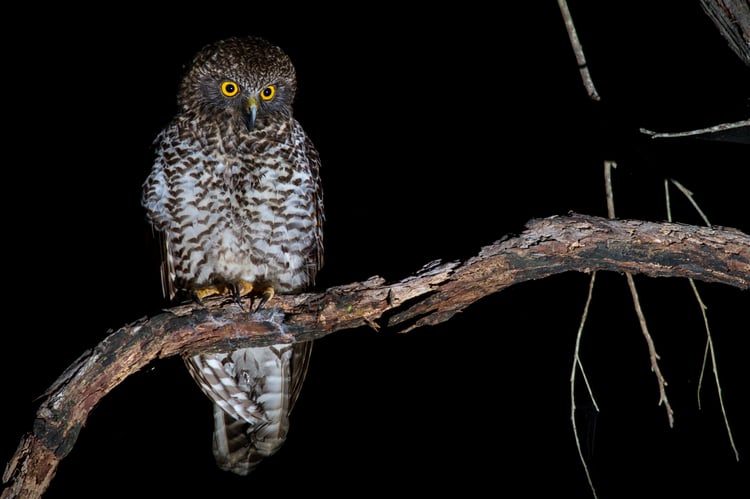Raptors -
birds of prey
- Home
- What We Do
- Wildlife information
- Species Information
- Raptors - Birds of Prey
WIRES receives over 1,700 calls annually to provide rescue advice and assistance for raptors, which are commonly known as birds of prey.
Australian raptors include Eagles, Falcons, Hawks, and Owls.
If you find a sick, injured or orphaned bird of prey please call WIRES Rescue Line 1300 094 737 or fill in WIRES online Rescue Form.
Do not touch these animals as they have sharp talons and strong hooked beaks and should be assisted by trained rescuers. While waiting for a rescuer to arrive please keep people and pets away and observe from a safe distance.
Mullyang
Committed to increasing capacity for best-practice raptor rehabilitation in Australia, WIRES has purchased, upgraded, and relaunched a raptor rehabilitation facility in NSW. WIRES Wildlife Centre specialising in raptor rehabilitation is called Mullyang, which is the Gundungurra name for Wedge-tailed eagle.
Mullyang is the largest free flight aviary complex of its kind in the Southern Hemisphere, and WIRES' vision is to build and manage more facilities where they are geographically needed to meet the rehabilitation requirements of birds of prey.
Extinction Risk
Australia is home to 36 species of raptors which are crucial to maintaining healthy ecosystems.
At least 17 of these species are currently listed as threatened. However, conservation statuses vary across the IUCN Red list, Australian EPBC Act List, and states and territories. Listings can also change over time due to ongoing environmental pressures and conservation efforts.


Key threats
Key threats facing raptors include habitat loss and fragmentation, climate change, poisoning and pesticides, illegal persecution and human conflict, vehicle collisions, invasive species (e.g. competing for nesting sites and predation of nestlings and juvenile birds), reduced prey availability, and disturbance from human activities. To help combat these threats habitat protection and restoration is essential, as are more legal protections and anti-poaching efforts.
More research and ongoing monitoring of raptors populations and increased public education and awareness campaigns are also needed.
Raptor Information
Australian raptors are a mix of diurnal (daytime) and nocturnal (nighttime) hunters, characterised by their keen eyesight, sharp talons, and hooked beaks. As carnivores and apex predators, birds of prey help regulate populations of other species, including mammals, reptiles, birds, and insects.
Eagles
Eagles are among the largest and most powerful raptors and there are 3 species found in Australia. Eagles are known for their impressive wingspans and soaring flight.
The Wedge-tailed Eagle is Australia’s largest bird of prey, with a wingspan of up to 2.5 metres.
- Little Eagle (Vulnerable in NSW)
- Wedge-tailed Eagle (Tasmanian sub-species Endangered)
- White-bellied Sea-Eagle (Vulnerable in NSW)
Falcons
Falcons are smaller, agile raptors known for their speed and precision in hunting and there are 6 species found in Australia.
The Peregrine Falcon is the fastest bird in the world, capable of reaching speeds over 300 km/h during dives.
- Australian Hobby
- Black Falcon (Vulnerable in NSW)
- Brown Falcon
- Grey Falcon (Vulnerable)
- Nankeen Kestrel
- Peregrine Falcon
Hawks
Australia is home to 15 species of hawks, which include goshawks, sparrowhawks, harriers, kites and buzzards.
- Brown Goshawk
- Collared Sparrowhawk
- Christmas Island Goshawk (Endangered)
- Grey Goshawk
- Red Goshawk (Endangered)
- Black Kite
- Black-shouldered Kite
- Brahminy Kite
- Letter-winged Kite (Near Threatened)
- Square-tailed Kite (Vulnerable in NSW)
- Whistling Kite
- Spotted Harrier (Vulnerable in NSW)
- Swamp Harrier
- Black-breasted Buzzard (Vulnerable in NSW)
- Pacific Baza
Owls
There are 11 owl species in Australia, including Boobooks.
- Barn Owl
- Barking Owl (Vulnerable in NSW)
- Powerful Owl (Vulnerable in NSW)
- Eastern Grass Owl (Vulnerable in NSW)
- Masked Owl (Vulnerable in NSW)
- Lesser Sooty Owl
- Rufous Owl
- Sooty Owl (Vulnerable in NSW)
- Australian (Southern) Boobook
- Christmas Island Boobook (Vulnerable)
- Tasmanian Boobook
Ospreys
- Eastern Osprey
How you can help
Slow down when driving in known wildlife areas, as birds of prey can become victims of secondary collisions when feeding.
If you see a sick, injured or orphaned raptor, contact your local wildlife rescue organisation or WIRES, and consider training to become a volunteer raptor rescuer.
Avoid using dangerous pesticides that can be ingested by raptors when feeding and report any suspected cases of poisoning.
Help with community education to assist others understand the threats facing raptors and the important role they play in the Australian ecosystem.
Support WIRES work with raptors, your support enables WIRES to provide critical emergency raptor rescue, rehabilitation, and preservation.
Report a Rescue
For wildlife rescue assistance you must call 1300 094 737 or fill in the Report a Rescue form. All other forms of contact including Facebook are not monitored for rescues.